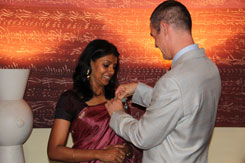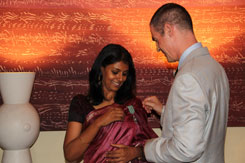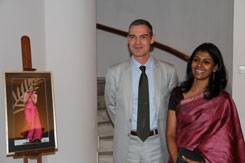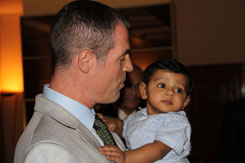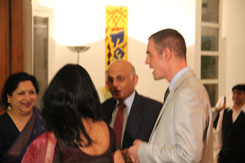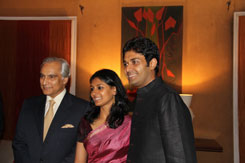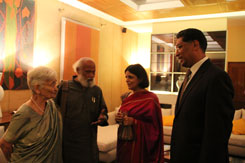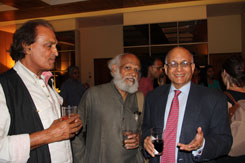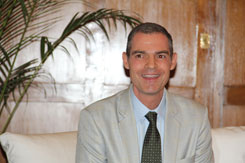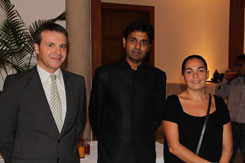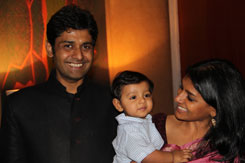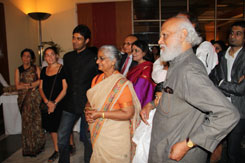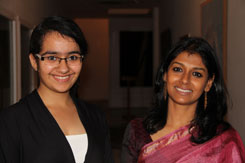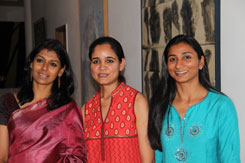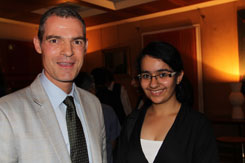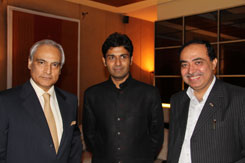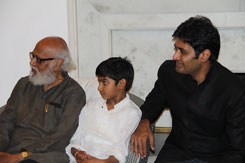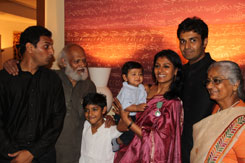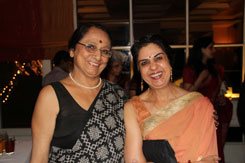
Art & Culture
|
Legendry artist M F Husain passes awayLONDON, June 9: Celebrated Indian artist M F Husain, who earned both fame and wrath for his paintings, died in London on Thursday after being unwell for over a month. He was 95. Popularly known as MF and regarded as "Picasso of India", the artist breathed his last at the Royal Brompton Hospital at 2.30 am local time. Husain had been keeping "indifferent health" for the last one-and-a-half month, family sources said. Born in Pandharpur in Maharashtra on 17th September 1915, Husain courted controversy over his paintings of Hindu goddesses. His paintings on goddesses Durga and Saraswati invited the wrath of Hindu groups which attacked his house in 1998 and vandalised his art works. In February 2006, Husain was charged with hurting sentiments of people because of his paintings. In the wake of legal challenges and death threats in his home country, Husain had been living abroad in self-imposed exile since 2006 and was offered Qatari citizenship in January 2010, which he accepted. As he had not responded to summons from an Indian district court in Haridwar, his properties in India were attached as per court orders and a bailable warrant was issued against him by the court. Though Husain had been saying that he was keen to return to India, his wish had remained unfulfilled. Three of Husain paintings recently topped a Bonham's auction in London, going under the hammer for Rs 2.32 crore with an untitled oil work in which the legendary artist combined his iconic subject matters -- horse and woman -- fetching Rs 1.23 crore alone. PM condoles M F Husain's demise Prime Minister Manmohan Singh has condoled the death of celebrated Indian artist M F Husain in London, terming it as a "national loss". In his condolence message, the Prime Minister termed Husain's demise as a national loss. Husain,95, who earned both fame and wrath for his paintings, died in London on Thursday after being unwell for over a month. Kumari Selja asks ASI to sensitize citizens on ancient monumentsBy Deepak Arora
Addressing the 35th meeting of the Central Advisory Board of Archaeology here today Kumari Selja said "we need to co-opt the willingness of every citizen so that the enactment is appreciated by them in the larger context and not perceived as a threat or impediment to their existence." The Minister said, in the amended form, the Act will be a useful tool in the preservation of monuments and heritage. She said "the amended Act also provides for considering the requests of the public to allow repairs in prohibited areas. The Act also says competent authorities will draft monument-specific heritage by-laws." Here is the full text of the Minister’s speech: “I am happy to be here at the 35th Meeting of Central Advisory Board of Archaeology (CABA) the august body, which advises the government on policy as well as all matters related to archaeology. The contribution of the Central Advisory Board of Archaeology (CABA) in furthering the activities of archaeology in this country is commendable. I congratulate the members for their suggestions and resolutions which have defined the scope, nature and direction of archeological works in the country. I would like to begin by referring to the last meeting of the CABA held in December 2009, where the Hon’ble Prime Minister had given clear and focused direction to ASI on a number of important issues. He had outlined the need and importance of collaborations between Governments, academic bodies, universities and research institutions. He said –“ I would like a genuine participatory approach to be developed between the central Government, Government of States, Archaeological Survey of India and Universities system of our country, that’s the only way we can carry forward this massive gigantic enterprise of preserving study of India’s past.” PM had also stressed on the publication of long-pending excavation reports and on proper archival management of priceless resources, such as glass negatives. I would like the Members of CABA to deliberate on whether these have been carried out, in letter and spirit, and are adequately reflected through quantum leaps, in efforts and expenditure. We really need to work hard to implement the advice and directions given by the Hon’ble PM, during his very eventful one-and-half years as the Minister for Culture which is quite historic. I am glad to learn that the Sub-committees of this CABA on Epigraphy, Monuments, Museums, Explorations & Excavation and Administration that were formed in the 34th meeting held on 2nd December, 2009 have deliberated on various subjects during the intervening period and I invite all of you to suggest, modify or amend any of the findings, before they are formally passed. Thereafter, I would like Secretary (Culture) and DG, ASI to prepare a time bound Action Plan to implement the recommendations. As I speak before you, we are in the midst of two important developments in the world of archaeology in India. The first is that since the last meeting of CABA, the AMASRA Act has been amended in March 2010. The Amendments are in the interest of better protection and maintenance of the monument precincts. With this objective, the amended act also provides for considering the requests of the public to allow repairs in the prohibited area which was not previously available. The amended Act also enjoins that the Competent Authorities are to draft monument-specific Heritage Bye-Laws, based on detailed survey of prohibited and regulated areas. In the amended form, this act will be a useful tool in the preservation of monuments and heritage and ensures that they receive much needed attention from both public and administrators alike. I would also urge ASI to launch a massive public awareness campaign and sensitise citizens to the provisions of the act. We need to co-opt the willingness of every citizen so that the enactment is appreciated by them in the larger context and not perceived as a threat or impediment to their existence. The second major milestone before us is that ASI is stepping into its 150th year. The last milestone for ASI was its 100the year in 1961, during the time of the first PM Pt. Jawahar Lal Nehru, whom be remember today with such gratitude and reverence. He, alonwith Maulana Azad, laid the path of culture in independent India. India being the repository of cultural heritage, it is befitting that in commemoration of its 150th anniversary, ASI should host an international conclave to deliberate on the issues of humanity’s shared cultural heritage. The conclave will not only reiterate our leadership role in this field but also help in identification of specific areas of collaboration between different nations and the ASI in the field of heritage, conservation, research and management. It would also be of tremendous interest to the public to have a glimpse of India’ culture and civilization as uncovered by the ASI in the last 50 years and for this ASI may consider mounting an exhibition on the rediscovery of India 1961-2011. On account of the 150 years of ASI, it is time not only for introspection, but also for re-working ASI’s vision, plans, schemes, approaches and its structure, to meet the challenges of implementing the amended AMASRA. I would, therefore, urge upon CABA to make positive suggestions to the ASI so that the 150th year celebrations do not become ritualistic, but lead to positive actions, with long lasting beneficial consequences. Secretary (Culture) has suggested the establishment of a “Forum for Archaeology in the East”, which could invite nations such as China, Japan, India and others, in pooling their knowledge and best practices in exploration, excavation, conservation and preservation. After 150 years, we can surely claim that archaeology in India is mature enough to lead the way for many of our sister nations in the East. We want that the 150th year celebrations of ASI should leave behind a positive and permanent network of archaeologists in the Eastern hemisphere. ASI also needs to respond to the ever increasing expectations of the people of India for the better preservation of their priceless monumental heritage. As the former Tourism Minister, I am personally aware of several inadequacies that our tourists, both domestic and foreign, have to contend with, at several of our monuments, and I insist that ASI should look into this aspect with more sincerity. While efforts are already underway in identifying the prominent monuments of ASI for public-private-partnership, I would urge you to pay more attention to monuments located in rural areas as well that cry for immediate attention and preservation. The monuments located in the remote areas of our country truly represent the heritage of the concerned region which is the pride of the locals. The betterment of these monuments would infuse new life for their survival and also assist in Tourism and local enterprises. This will essentially connect the present to preserving the past. We need to create these symbiotic inter linkages which eventually lead to generation of jobs and sustainable livelihoods. Friends, There is another major issue to which I need to draw your attention. The Planning Commission has constituted Working Groups for various sectors, including Culture, for developing the 12th Five-Year Plan and we are expected to submit our suggestions by end of October this year. I would like to invite you to assist us in this task of expansion and modernization of ASI. As you may be aware, the allocation of resources for Culture, which is only 11 to 12 paise out of every hundred rupees spent by the Central Budget (in Plan and Non-plan to-gether), arises largely due to the inability of our cultural institutions to ramp up their activities. Stress thus, has to be on capacity building, particularly in relation to implementation of schemes at the ground level. DG may explain the new schemes that are already under consideration, for incorporation in the 12th Plan. There is also a necessity to develop national charters on various subjects based on the international conventions and guidelines in this regard. The national charters can be on Conservation, Exploration Excavation, Museums, to name just a few. These charters can supplement the Acts and Rules that are already in force and provide a working methodology on various aspects related to heritage management. This should be on par with established global standards and make our documentative internationally competitive. I would urge the members to deliberate on the various issues in a comprehensive manner and come up with suggestions and solutions for the betterment of archaeological activities in our country in general and ASI in particular. I hope the two day meeting will be a good opportunity for fruitful discussions and deliberations. India, Afghanistan sign MoU for cultural cooprationBy Deepak Arora
The Memorandum of Understanding was signed by Culture Minister Kumari Selja and Afghan Minister for Information and Culture Dr Sayed Makhdoom Raheen in New Delhi on Friday. The MoU aims at sending Capacity Development Advisors (CDAs) from India for providing capacity development support to Afghanistan for policy and strategy development, project management, financial management, procurement and human resource management and a few technical areas. Promotion of art and culture, development of archaeological institutions, museums, libraries and archives, preservation and restoration of historical and cultural sites, promotion of cultural heritage of Afghanistan and marketing of cultural places to improve tourism in Afghanistan are some of the other areas of cooperation. The agreement is part of a broader pact on the National Institution Building Project (NIBP) signed on March 30,2010 between the Indian external affairs ministry's Independent Administrative Reforms and Civil Service Commission (IARCSC), the Afghan government and the United Nations Development Programme (UNDP) for facilitating public sector capacity development in Afghanistan. The contribution by the Indian ministry of culture shall be in kind in terms of provision of services of its experts and advisors according to the agreement. The Maharajas and their Magnificent Motor CarsBy Deepak Arora Photographs By Noyanika Arora
French Ambassador Jerome Bonnafont and Maharaj Shriji Arvind Singh of Udaipur released the book written by veteran automotive expert Gautam Sen. Speaking on the occasion, Ambassador Bonnafont said “it is a special book which talks about India and its heritage and its links with Europe and America. The French are aware that Indians have a magnificent history.”
Agreeing with the Ambassador, the author said that he now lives in France and “my wife being French was also one of the reasons that I first got this book published in France.” Another reason for its first publication in France was that “France's fascination with India is greater than India's fascination for France and that's why the book was out in French first,” added Sen.
Along the way one encounters lots of eccentric cars and explore themes such as motor sport in India and the position of Calcutta as the cradle of automotive activity in India.
The book also provides a fascinating insight into a changing society through the history of the Maharajas' cars. Each wealthy family tried to outdo the other in terms of pomp, glamour and splendor. The author has done extensive research and been afforded unique access into some of the most splendid car collections in India to create this authoritative and visually impressive study.
Shriji Arvind Singh, who is known for his exotic taste and vintage collection, said the best part of the book is the photographs as most of these cars are not found today and they lack documentation too.” He said a lot of people who collected cars thought that it would give them personal pleasure. “But the fact that there are books on them and car rallies makes it evident that collectors are now keen to share their collection with everybody.”
Two vintage cars - a 1934 Rolls Royce and a 1930 Stutz Series Le Baron – from Diljeet Titus’ collection were on display at the French Residence for the event, which was attended by collectors of vintage cars and admirers. Sen said “the Maharajas used to order the most expensive vintage wheels from across the globe and that used them to define their style. It was like their toy, their baby, their most prized possession.”
“Some the cars were of French origin and American in design and structure. All kinds of them were demanded and ordered by the royalties. I have known these owners for over many years and all of them helped me tremendously to complete this book that took me seven months of research,” said Sen.
New Indo-French Film Co-production Agreement Enters into EffectBy Deepak Arora NEW DELHI, April 28: A Indo-French Film Co-production Agreement has entered into effect and a special official ceremony for this agreement will be organised at India’s NFDC (National Film Development Corporation) pavilion jointly with CNC (French National Cinema and Motion Pictures Centre) during the 64th Cannes International Film Festival on May 15. The Indian film industry will also be honoured through the screening of “Bollywood: the Greatest Love Story Ever Told,” produced by Shekhar Kapoor and UTV Motion Pictures, in the Cannes ‘Out of Competition’ section. The new agreement for Indo-French Film Co-production agreement was signed on December 6, 2010 by India’s Information and Broadcasting Minister Ambika Soni and French Minister of Culture and Communications Frédéric Mitterrand in New Delhi in the presence of French President and Indian Prime Minister Manmohan Singh. This Agreement which came into effect on April 1, 2011, will encourage film collaborations and exchanges between producers of France and India. It has more flexible terms than the previous co-production agreement signed between the two countries on January 16, 1985, allowing for the producers from each State to contribute between 20 to 80 per cent to a co-produced film. On an exceptional basis, with the approval of the French and Indian authorities, the minimum contribution can be reduced to 10 per cent. Nandita Das becomes French KnightBy Deepak Arora
Critically acclaimed for performances in films like Fire, Earth and Bawander and her debut directorial venture Firaaq, the 41-year-old actor was given the insignia of a Knight by French Ambassador to India Jérôme Bonnafont at an elegant ceremony here on Friday. Speaking on the occasion, Ambassador Bonnafont said Nandita Das is highly respected actress in France and rest of the world because of her inimical artistic style.
Referring to Nandita as “L’artiste Engage”, the Ambassador said “in France artists get naturally involved in social and political national issues and it is for this reason they are considered as super citizens. Nandita and her work is quite close to the French tradition of artistic activist cinema...which relate to deepest intimacy of personal tragedies or to bigger national issues." While dedicating to her the co-production deal signed between France and India in the field of cinema, the Ambassador said French love Indian art and culture.
After staying in front of the camera and proving her mettle as an actress, Nandita went behind the camera in 2008 to direct “Firaaq”, a political thriller on the aftermath of the 2002 Gujarat riots. Her directorial debut got her two national awards and a popular Filmfare Award. Directing a film is a challenging experience, she added. “It is very fulfilling, tough and very lonely.” She said she would love to direct another film, but not for now as she has an eight-month-old baby. Nandita also received recognition at the film festivals of Santa Monica (2001), Cairo (2002), and Madrid (2007). In 2005, she served as a jury member at the Cannes Film Festival.
Besides Nandita, Rahul Bose, Juhi Chawla and Sanjay Suri play the lead roles in the film, which shows how social presumptions stand firm against exercising personal choices. Thanking and appreciating the Ambassador, Nandita said that it was the first time that she was asked to invite her near and dear ones, her family and friends for an award ceremony.
Present on the occasion were her parents -- noted painter- father Jatin Das and writer-mother Varsha, her husband, Subodh Maskara, and her eight-month-old son, Vihaan, whom the actor introduced to guests at the function. “It is good to get the award in Delhi, which is my home, and in the presence of family and friends, including my little son and distinguished gathering,” she said. Her son was connoisseur of all eyes and the child was happy when the Ambassador held him in his arms. "Being a mother is one of the most beautiful and delightful journeys," she added.
“Chevalier dans l'Ordre des Arts et des Lettres” award is given to writers, filmmakers, musicians and other artists and persons who have distinguished themselves in the field of art, culture and literature or for their contribution to the influence of arts in France and throughout the world. Fashion designer Ritu Beri, late theatre personality Habib Tanveer, musician Hari Prasad Chaurasia and author Upamanyu Chatterjee are among previous Indian recipients of the award instituted by France in May 1957. |
|
||||||||||||||||||||||||||||||||||||||||||||||||||
Aviation
| Business | Defence
| Foreign Affairs | Communication
| Health | India |
United Nations
India-US | India-France
| Entertainment | Sports
| Photo Gallery | Tourism
| Advertise with Us | Contact
Us
© Noyanika International, 2003-2009. All rights reserved.
 NEW DELHI, May 27: Union Minister of Culture Kumari Selja has asked the Archaeological Survey of India to launch a massive public awareness campaign and sensitise citizens to the provisions of the Ancient Monuments and Archaeological Sites and Remains, Amendment and Validation (AMASRA) Act.
NEW DELHI, May 27: Union Minister of Culture Kumari Selja has asked the Archaeological Survey of India to launch a massive public awareness campaign and sensitise citizens to the provisions of the Ancient Monuments and Archaeological Sites and Remains, Amendment and Validation (AMASRA) Act. 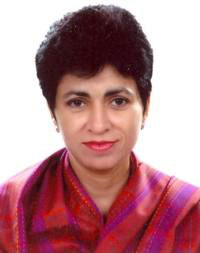 NEW DELHI, May 27: India would provide capacity development support in various areas to Afghanistan and cooperate with it in promotion of art and culture, development of archaeological institutions under a new MoU signed between the two countries.
NEW DELHI, May 27: India would provide capacity development support in various areas to Afghanistan and cooperate with it in promotion of art and culture, development of archaeological institutions under a new MoU signed between the two countries.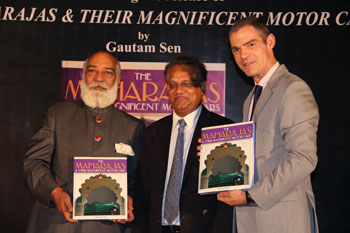 NEW DELHI, April 27: A glimpse into the lives of former Indian Maharajas and their exotic and exclusive cars can be had in a new book titled “The Maharajas & their magnificent motor cars” was launched here at the French embassy.
NEW DELHI, April 27: A glimpse into the lives of former Indian Maharajas and their exotic and exclusive cars can be had in a new book titled “The Maharajas & their magnificent motor cars” was launched here at the French embassy.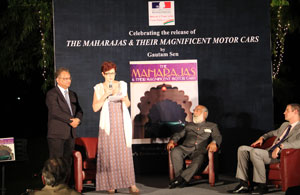 Ambassador Bonnafont informed that before being published in English, the book was first published in French a few months ago.
Ambassador Bonnafont informed that before being published in English, the book was first published in French a few months ago.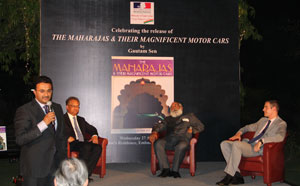 The book covers 70 of the few hundred surviving vintage cars in India. It is packed with interest and insight and the text is supported by more than 500 photographs of ceremonial throne cars, hunting cars, cars for wedding and state processions and those made especially for ladies so that they could travel in secluded purdah.
The book covers 70 of the few hundred surviving vintage cars in India. It is packed with interest and insight and the text is supported by more than 500 photographs of ceremonial throne cars, hunting cars, cars for wedding and state processions and those made especially for ladies so that they could travel in secluded purdah. 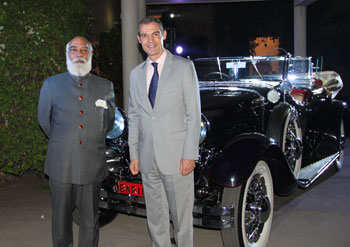 The book also talks about a Swan car that of Calcutta, a 1912 Brooke with the front end fashioned to look like a swan that hissed steam from its nostrils and to a Rolls-Royce converted to transport a king's personal cricket team.
The book also talks about a Swan car that of Calcutta, a 1912 Brooke with the front end fashioned to look like a swan that hissed steam from its nostrils and to a Rolls-Royce converted to transport a king's personal cricket team. 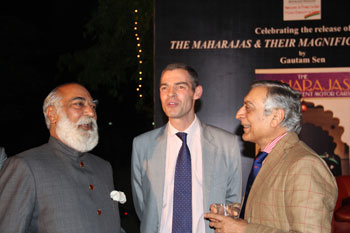 The book, brought out by Haynes Publishing, has 384 pages and is priced at 40 pounds. It is a study on the historically beautiful and unique traits of these automobiles.
The book, brought out by Haynes Publishing, has 384 pages and is priced at 40 pounds. It is a study on the historically beautiful and unique traits of these automobiles. 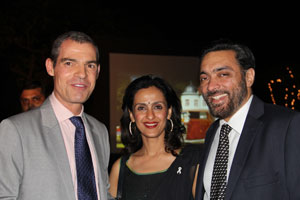 Eminent collectors Nitin Dossa, Dr Ravi Prakash and Diljeet Titus also spoke highly about the book.
Eminent collectors Nitin Dossa, Dr Ravi Prakash and Diljeet Titus also spoke highly about the book.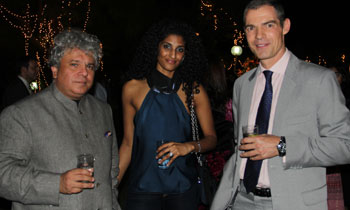 The black and white image of one of the oldest cars to arrive in India, a Gobron-Brillie from 1903 owned by Lord Wolverton, with Maharani Stella of Kapurthala standing with it, is one of the interesting photographs.
The black and white image of one of the oldest cars to arrive in India, a Gobron-Brillie from 1903 owned by Lord Wolverton, with Maharani Stella of Kapurthala standing with it, is one of the interesting photographs.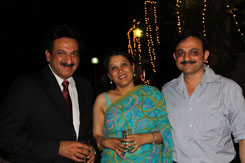
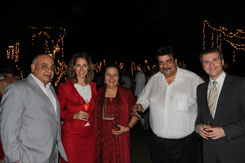
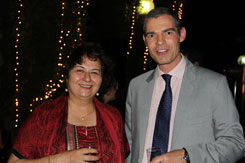
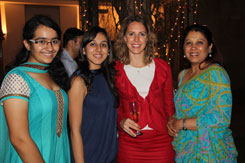
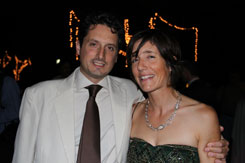
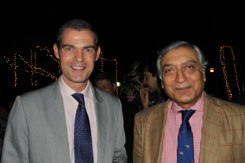
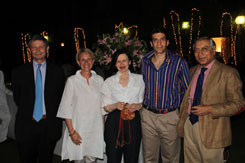
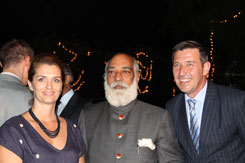
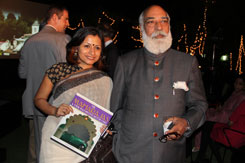
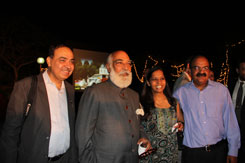
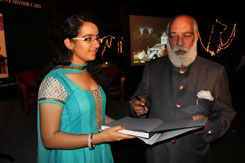
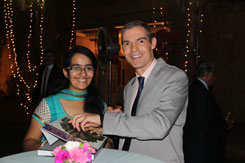
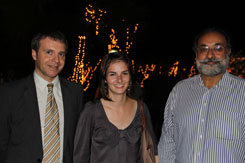
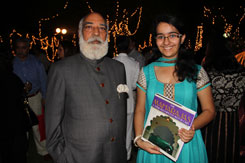
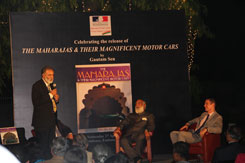
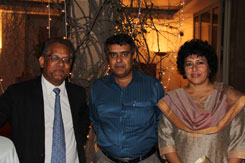
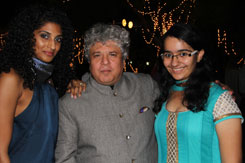
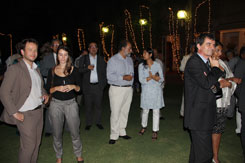
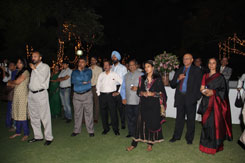
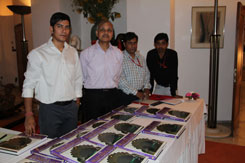
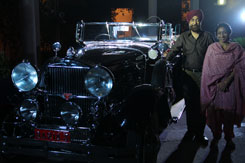
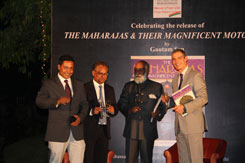
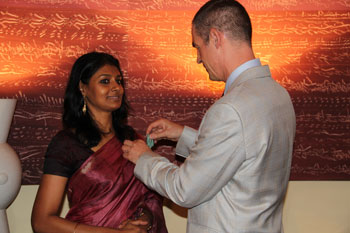 NEW DELHI, April 15: Actor-director Nandita Das has been conferred France’s highest cultural award “Chevalier dans l'Ordre des Arts et des Lettres” (Knight of the Order of Arts and Letters) for her contribution to the development of Indo-French cooperation in the field of cinema.
NEW DELHI, April 15: Actor-director Nandita Das has been conferred France’s highest cultural award “Chevalier dans l'Ordre des Arts et des Lettres” (Knight of the Order of Arts and Letters) for her contribution to the development of Indo-French cooperation in the field of cinema.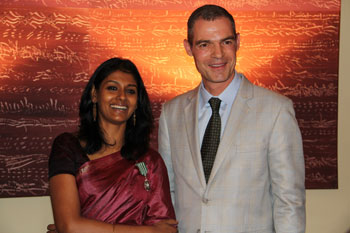 “It is for this reason the French like her and she is perceived as extremely positive artiste in France. Her films remind us of the leading ladies in French cinema,” said Ambassador Bonnafont.
“It is for this reason the French like her and she is perceived as extremely positive artiste in France. Her films remind us of the leading ladies in French cinema,” said Ambassador Bonnafont. 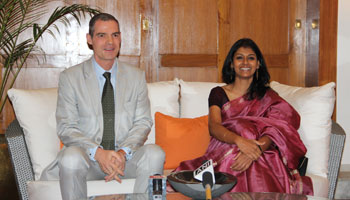 Thanking the French Government and the Ambassador for the honour, Nandita Das said “it has come as a pleasant surprise and it reinforces my faith in the kind of cinema I am doing.” She was reacting to often asked question as to why she does not do commercial cinema.
Thanking the French Government and the Ambassador for the honour, Nandita Das said “it has come as a pleasant surprise and it reinforces my faith in the kind of cinema I am doing.” She was reacting to often asked question as to why she does not do commercial cinema. 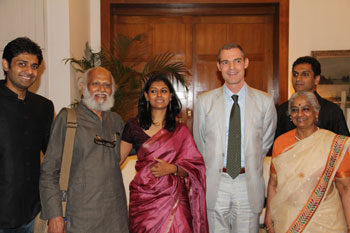 Talking about her forthcoming film “I Am”, set to be released in later part of April, she said the film is based on four stories of struggle for individuality and personal choices and she plays a lead role of a woman who chose to be a surrogate mother. Directed by Onir, she said the film deals with the journeys of four characters that are entwined with one another.
Talking about her forthcoming film “I Am”, set to be released in later part of April, she said the film is based on four stories of struggle for individuality and personal choices and she plays a lead role of a woman who chose to be a surrogate mother. Directed by Onir, she said the film deals with the journeys of four characters that are entwined with one another.